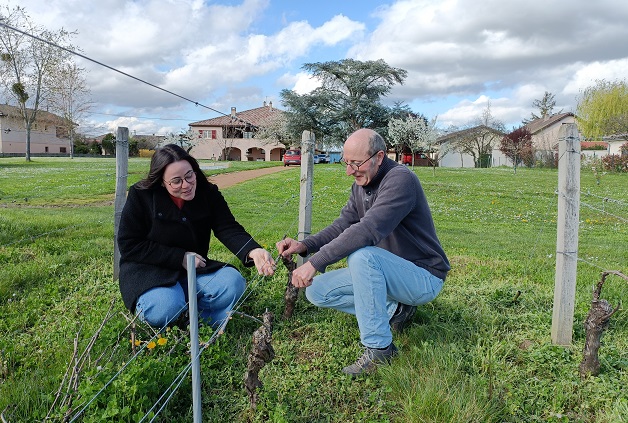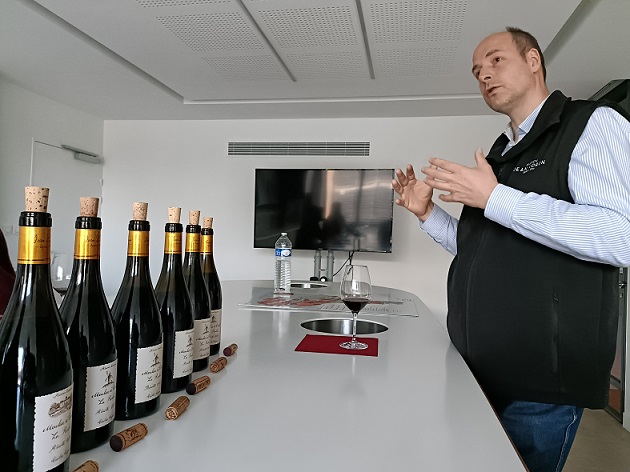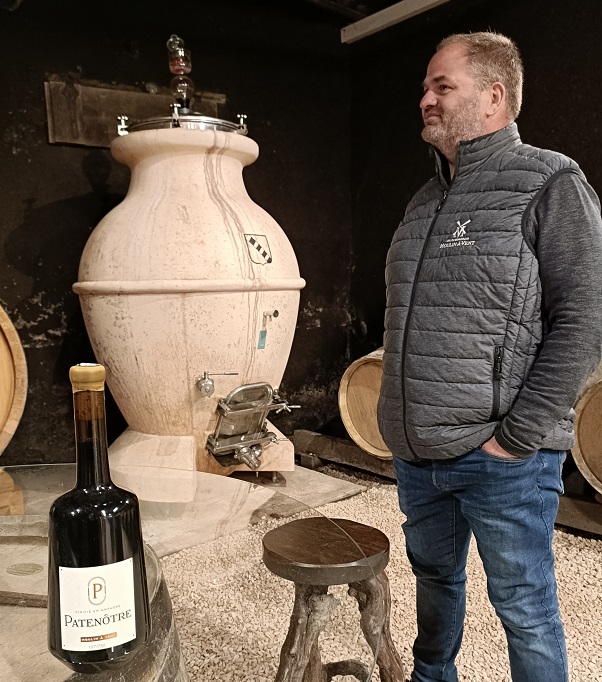As part of the centenary celebrations, Canopy visited the region – the spiritual home of whole-bunch fermentation – to uncover the secrets of semi-carbonic maceration.

Moulin-à-Vent, in the very north of the Beaujolais region, gets its name from the 15th-century windmill overlooking the vines. The 10m-high windmill, in the northwest of Romanèche-Thorin, is the backdrop to the best terroirs of the appellation and bears witness to the strong winds that sweep through it, bringing freshness during the hottest hours and stressing the vines, so they produce small, highly concentrated berries.
One grape variety dominates the landscape – Gamay, which was banned from Burgundy by Philip the Bold, then Duke of Burgundy, in 1395, in favour of his preferred Pinot Noir (one of the parents of Gamay). But here in the pink granite soils of Moulin-à-Vent, Gamay produces complex, vibrant wines with significant ageing potential that resemble Pinot Noirs in cooler years and northern Rhône Syrahs in warmer vintages, according to Brice Laffond (below), winemaker at Château du Moulin-à-Vent.
The wines also fit in well with current consumption trends: fruit-forward, fresh, with good drinkability and moderate alcohol levels, even in very sunny years.

The winemaking
Growing the grapesThe early ripening Gamay is generally pruned short (like goblet or cordon de royat) to control the yield and extend the vines’ lifespan.
Harvesting the grapes
Most of the estates I visited were family-owned and run. They had a decidedly artisanal feel about them with the winemaking largely entrenched in tradition.
“Our parents, grandparents and great-grandparents... lived and worked in this little corner of Beaujolais,” said Patrick Boulay, who runs the family estate Domaine des Michelons with his wife Véronique. His comment was echoed in many tasting rooms in the two communes: Romanèche-Thorins and Chénas.
Tradition here means manual harvesting.
Vinification
The technique that sets Beaujolais apart from many other regions is the widespread use of semi-carbonic maceration. The crushed grapes at the bottom of the (usually) concrete tank start to ferment (with native or cultured yeasts or a pied de cuve), filling the vessel with carbon dioxide. The intact berries higher up in the temperature-controlled tank undergo carbonic maceration: whole-bunch, intracellular fermentation.
As the process continues, increasing quantities of juice spill from broken or bursting grapes during twice-daily pumpovers in the early stages of fermentation, reducing to once a day as the sugar level drops. At some point during the later stages of fermentation, the grapes are pressed. Most of the producers I met seemed to press the skins when there was still a little life in the fermentation to protect the juice from oxidation.
The percentage of whole bunches varied, but nearly every winemaker agreed on the principle. “If we destem the grapes then we have more bitterness,” Jean Etienne Chermette of Domaine Famille Chermette explains. “If the stem of Gamay are ripe, with whole bunch we obtain wine with round tannins and more fruity.”

Richard Rottiers (above), originally from Chablis, opts for 100% whole bunches in cement tanks, inoculating with a pied de cuve straightaway, pumpovers in the morning and evening at the start of fermentation, then a grid (“grillage”) to keep the cap submerged (which is gentler than pumpovers) and pressing after about 10 days’ maceration.
“I don’t want to have a long maceration because I prefer to stay on the fruit,” he tells me as we taste through the extensive portfolio at organic Domaine Richard Rottiers.
Richard goes on to explain that the length of the maceration is determined by the maturity of the stems. If they are from young vines, the stems will be left in for nine or ten days, but the bunches from his prime vineyards can be left in the tank for three weeks.
Fermentation temperature is 25-26°C “to keep the fruit”.
As for using 100% whole bunches, Richard says: “I love it. It gives you something very fresh and a special structure that you cannot have with destemmed vinification.”
All the winemakers I met during a three-day visit said MLF usually occurs naturally. Château du Moulin-à-Vent’s Brice Laffond says that when you use whole bunches, natural MLF often happens at same time as fermentation.

Domaine Famille Chermette “always” has used 100% whole clusters. Jean Etienne Chermette (above) reveals he is maintaining the tradition that worked for his father and grandfather. The modern changes, brought on by climate change, involve the length and frequency of the pumpovers during the ten-day maceration period.
It’s twice a day (morning and evening) for ten minutes at the beginning “to extract the structure and the colour but softly – it’s not a strong extraction”. As the fermentation peters out, he reduces pumpovers to once a day.

Typically, Paul Janin & Fils opts for 70% whole clusters, but Eric Janin (above) destemmed all his Gamay in the difficult vintages of 2019 and 2021. He inoculates with a neutral yeast, likes the fermentation temperature to be around 31°C (33-34°C maximum) and presses after 12-14 days.
At the beautiful Château du Moulin-à-Vent, the average is around 50% whole clusters but they check the maturity of the stems in each parcel before making the final decision. “We don’t have a recipe,” Brice explains.
They also use a pied de cuve to kickstart the 12 to 16-day fermentation. Brice feels one pumpover a day is enough, explaining: “It’s closer to infusion than true extraction.” But if there is a higher percentage of stems in the tanks, they punchdown at the beginning to release “more juices and more sugar”.
Fermentation temperature is kept under 25°C, typically at 23°C.
What they do here that’s a little different is bleeding off some of the juice for a rosé. But it also gives them the option of blending some of it back if necessary.

Maison Jean Loron, which has 220ha spread over the Beaujolais and Maconnais regions, uses 20% whole clusters. They are there “to drain the juice and facilitate the pumping over”, according to Emmanuel Charpentier (above), who runs the laboratory, which offers its services to other wine producers in the region.
They harvest “very ripe” grapes and inoculate the juice straightaway with very neutral yeasts “to keep the expression of the soil” – but this strategy means they don’t have to use sulphites at the start of vinification.
The fermentation in tanks takes place at under 30°C, pumping over in the morning and afternoon during the first half of fermentation, then switching to once a day for the rest of the two- to three-week-long maceration. The decision to stop and press is done by taste. “We try to extract the more interesting things,” Emmanuel comments.
Pressing
A soft, gentle pressing is the norm.
Most put a large portion of the pressed juice back in the blend. Richard Rottiers explains: “Each part brings something and the balance comes from that.”
At Château du Moulin-à-Vent they press before the end of fermentation “because you still have 30g of sugar in some bunches”. Most of the pressed juice goes back into the mix, keeping the very last fraction separate in case there is the need for “some correction”.
Maison Jean Loron presses at the end of fermentation, and they wait three or four days for the wine to clarify before sending it for ageing in French oak barriques (equal percentages of new, second and third fill). Most of the producers like to put relatively clean wine into barrels…
Ageing
64% of the single-vineyard cuvées are released for sale at least 15 months after harvest across the AOC. 47% of the wines have an ageing period ranging from 11 to 18 months.
23% of the wines have an ageing period of more than 19 months.
Richard Rottiers ages threequarters of his wines in concrete tanks “because it keeps the fruit and I really like that. And people like more the Gamay with nice fruit”. However, he blends it with varying percentages of wines aged in used 228L barrels (from the family winery in Chablis) to “add more structure to the wine and tannins”. The wines are aged for up to ten months in barriques – “never more because otherwise you lose the fruit”.
Château du Moulin-à-Vent ages the batches separately for nine months: one third in 228L used barrels and two-thirds in tanks. After blending, the wine goes into a tank for another nine months for further ageing and clarification. Brice sees the blend “like a puzzle – you have many different parcels, many different times when you pick the berries and what I want to do is not put anything (else) in the wine”.
Domaine des Fontaines’ exceptional Moulin a Vent 2020 Clos des Michelons – from the vineyard closest to the house – is fermented in cement but sees 12 months’ ageing in French barriques. But it’s the only wine that sees so much oak because grapes from other sites are “too pretty, too delicate”, according to Nicolas Loron.
Domaine Famille Chermette ages its Moulin à Vent wines for six months in foudre to help make the tannins “soft and round and to stabilise the colour”.
At Domaine de la Sionnière, Estelle and Thomas Patenôtre age one of their wines, Patenotre Amphora, in a clay vessel for 18 months. Thomas (below) thinks the vessel “performs like a foudre but without any wood notes”.

Bottling
Château du Moulin-à-Vent lets the wine clarify naturally. They simply add a little sulphur (15-20mg/L free) for bottling.
Maison Jean Loron doesn’t add any sulphites until spring, then they add 3g/hl. Gamay, Emmanuel says, is sensitive to sulphites: “the more you add sulphites the less intensity”. The wine is bottled before the next harvest without fining and with a light filter. The SO2 level is 12-15mg/L free – except in their no-sulphite wine.
A few producers showed wines with no-added sulphites.
It was certainly an interesting time to visit this beautiful wine region.

 English
English French
French







.png)


